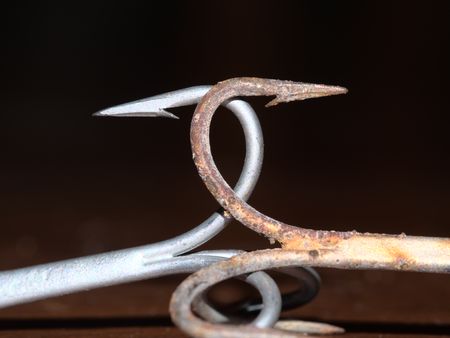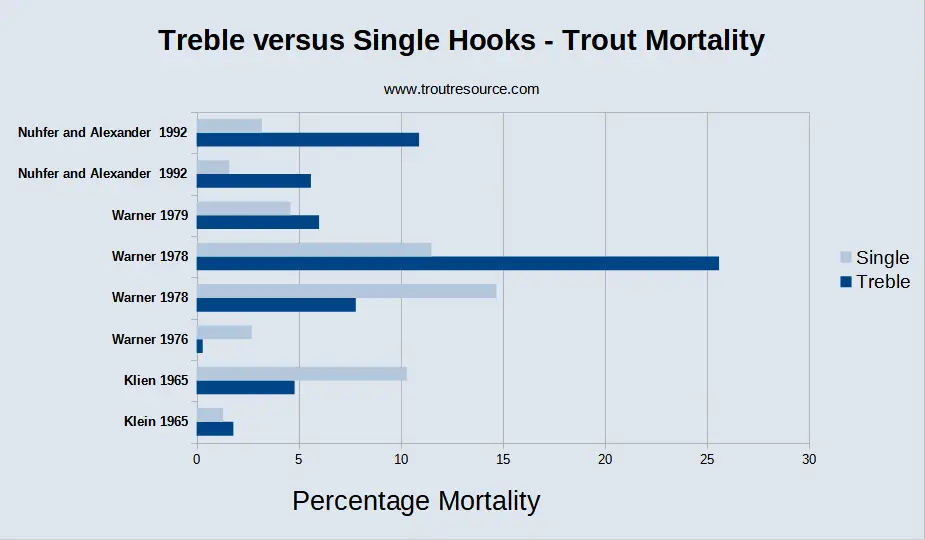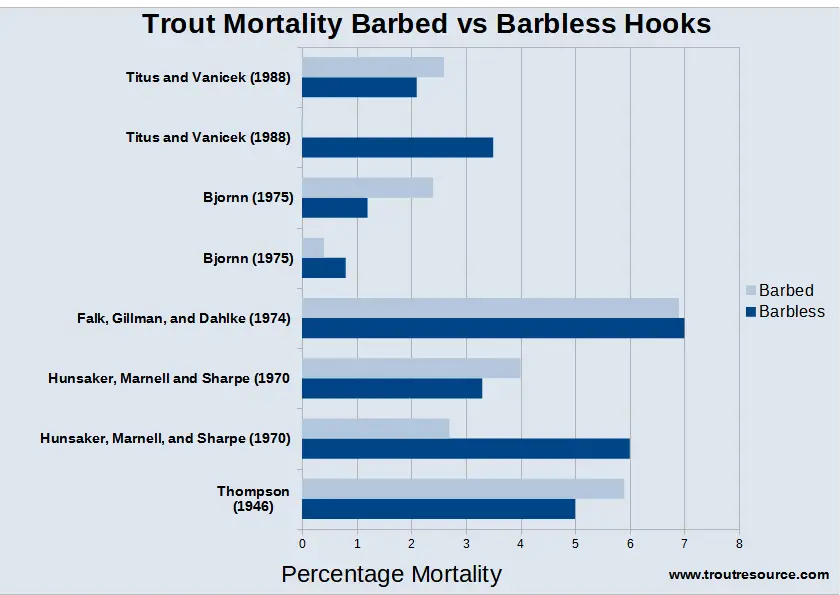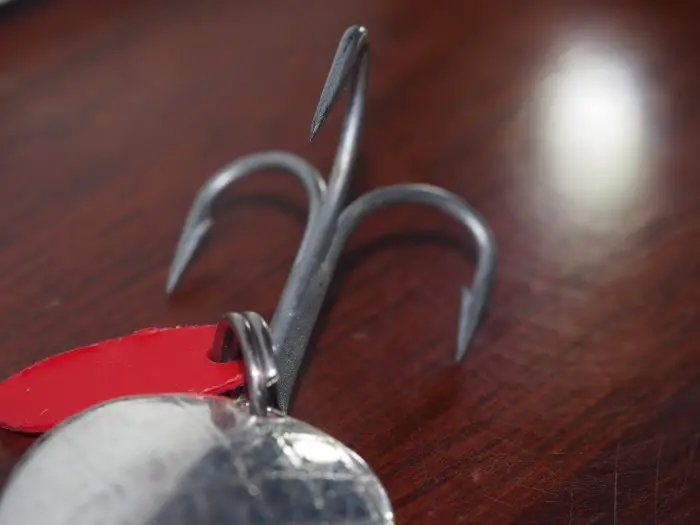Most of us care deeply about the trout we catch and the continued health of the fishery. When releasing trout, we want them to survive, thrive, and reproduce. A trout that dies shortly after release, is the worst possible outcome.
Over the years, there has been a lot of controversies over which hook type damages trout the most. With many fishermen choosing to replace trebles with single hooks, but are single hooks actually better? Does using single hooks reduce trout mortality.
Like most fishermen, I have my own opinions and preferences. But anecdotal experiences only go so far. What does more Indepth research actually shows? Well, there has been numerous studies looking at exactly that and I will share the findings below. The findings might surprise some people, and go against some deeply held views.
At the end of the day, all fishermen who practice catch and release want to use the hook which has the lowest fatality rate for returned fish.

Single or treble hooks?
A common sentiment that I often hear, Is that single hooks are the best choice. Their fans claim they kill fewer trout and are easier to remove speeding up release time.
One puncture hole has to be less damaging than three? Treble hooks do seem to rough up a trout’s mouth pretty bad.
Well, there has been numerous studies comparing hook design and trout fatality. And the answer is not that simple. I feel this quote, from a meta analysis of 18 studies sums it up best.
“There was no evidence to suggest that hook size
A Meta-Analysis of Hooking Mortality of Nonanadromous Trout (4).
or hook number had any relationship to hooking
mortality”
To summarise the findings of the research papers.
There were no significant differences in fish mortality between single and treble hooks. No hook type was best for all lure styles and sizes of fish.
This is because single hooks were more likely to be swallowed deep, hooking trout in the gills or throat lining. While the many points of the treble hooks caught most trout in the jaws or mouth where trout are less venerable to serious injury.
A wound to the grills has nearly a 40% fatality rate. Contrast that against a 5% fatality for a trout hooked in the jaw or mouth.
This fact alone certainly shows the best hook design is not black and white. Where a trout is caught matters more than how it is caught.
One research project (1) looked at the fatality rate of trophy brook trout caught on Mepps Spinners, Cleo Spoons and Rapalas. These lures were rigged with either treble or single point hooks. In both barbed and barbless variations.
During the first 48 hours, there was a 8.3% fatality rate for trophy size brook trout caught on Mepps Spinner or Cleo Spoon using a treble hooks. While only a 2.4% fatality rate using single hooks.
So are single hooks the best? Well not quite and I will need to reference other studies to explain why.
Another study compared trout mortality when caught on single or treble hooked when fished on #1 Mepps spinner. They found no significant differences in trout mortality.
“The mortality of rainbow trout Oncorhynchus mykiss, brown trout Salmo trutta, and brook trout Salvelinus fontinalis was low (,4%). Hook types did not differ significantly in causing mortality or severe eye damage of rainbow trout or brown trout.“
Effect of Hook Type on Mortality, Trauma, and Capture Efficiency of Wild Stream Trout Caught by Angling with Spinners
Now let’s look at treble hooks on jerk baits. In the first study. There was a 0% fatality rate for the 126 trout caught on Rapalas. Despite them using two treble hooks.
Why was that the case? The researchers theorized that Rapalas wobbled more side to side vastly increasing the likelihood of the hooks contacting the jaws.
I personally speculate the more hooks the earlier it well pierce making jaw captures the more probable.
With regards to small inline spinners, trout were simply more likely to fully engulf a straight swimming inline spinner which meant more fished hooked deeply. In that case, the more points the more dangerous it is to the trout.
The researchers also found that “Hooking mortality estimates for trout caught on Mepps or Cleo lures were positively and significantly correlated with size of fish.”.
That means, the larger the trout, the greater the chance it would engulf the smaller hardware causing serious damage.
The table below, summarizes many studies showing the difference in mortality between single and treble hooks. Sometimes single hooks are better, and sometimes treble hooks are better. It is certainly not black and white, and the best hook really depends on many variables.

Barbless hooks might not actually be better.
If there is one piece of advice, I have heard more often than any other is to use barbless hooks.
There is perennial dispute surrounding the advantages of barbless versus barbed hooks. The relentless advocates of barbless hooks maintain that their design facilitates easier hook removal, ultimately resulting in reduced tissue damage to the caught fish. It is also well known that a faster release is beneficial for trout survival.
On the other side of the spectrum, opponents staunchly argue that barbed hooks lead to decreased mortality rates, contending that the barb’s presence prevents the hook from penetrating critical areas, such as the delicate roof of the fish’s mouth, too deeply.
In the graph below I have compiled the results of 8 studies which looked at the difference in trout mortality when using barb or barbless hooks.

Across all studies the mortality rates for barbed hooks averaged 2.5%, while for barbless hooks, the average was 2.6%. Statistical analysis revealed that these values do not exhibit a significant difference (P = 0.424).
Notably, the mortality rates for both hook types on artificial flies and lures remained consistently low. Taken together, the results from all the studies conducted so far strongly suggest that there is no discernible advantage in using either barbed or barbless hooks.
This means, I can only conclude to use whatever method you are most comfortable with. I personally prefer barbless, due to the ease and speed of removal. I also had to remove hooks from my flesh, removing barbless is a lot less painful.
Does fly fishing have lower mortality than spinning?
I think we have all met the fly fishing purist, someone who looks down on anyone using spin tackle or bait fishing. I love trout fishing and have caught a lot of trout on both the fly and spin rod.
Unfourntantly, at this time I can not find any papers directly comparing trout mortality caught on spinner vs flies. But I do know both spinners and flies generally have a mortality of under 8%.
In my own personal experience, a hook on a fly can be just as lethal as a hook on a spinner.
But, do flies kill fewer trout than spinners? If I consult my own personal fishing journal, I find that I have a comparable number of ‘badly hooked’ trout fishing Streamers as I do fishing single hook inline spinners.
Large terrestrial dries also do not fair much bigger. I suspect these large streamers retrieve straight and feel somewhat natural so the trout will try to swallow rather than immediately spit them out. This increases the chance of throat or gill injuries.
The flies which do seem less-lethal are small nymphs and dries. I can count on one hand the number of badly hooked trout I have caught on nymphs.
Circle Hooks vs J-Hooks
As trout fishermen do not use circle hooks enough. They can actually be very hard to find in small sizes appropriate for trout fishing.
Circle hooks are specially designed to hook fish in the corner of the mouth, and some anglers even report that fish are less likely to escape. A normal hook can easily pierce into soft flesh, which can tear during the fight. This is less likely to occur with a hook piercing through the bony jaw. Although, research does not agree with the anecdotal evidence I have heard.
Fewer fly-fishing-caught fish were injured using circle hooks, and circle hooks tended to hook fish in only one location, generally in the jaw. Barbed J hooks were more efficient at landing fish, and J hooks were more efficient at landing fish than circle hooks.
The Influence of Hook Type, Angler Experience, and Fish Size on Injury Rates and the Duration of Capture in an Alaskan Catch-and-Release Rainbow Trout Fishery ( Meka, Julie M)
Something which is little known, Circle hooks do not need to be super sharp to work. A slightly blunter hook Is less likely to pierce the trout’s mouth as it rolls towards the jaw.
While circle hooks are usually the domain of the bait fishermen. Some keen fishermen have started to use them on lures. Feedback has been positive. Many require the use of double split rings to get the hook to run straight.
Trout Fatality increases with warmer water.
Studies also show, that released brook trout are more likely to survive when water temperatures are low. Badly hooked Brook trout have a much higher chance of survival with water temperatures below 14c. This is probably due to a combination of higher oxygen levels, and lower fish metabolism due to the cooler temperatures.
Cut the line or remove swallowed hooks?
Trout have the best chance of survival if the line is cut. Most trout die within 24 hours of a hook being removed. Trout have approximately a 70% chance of survival if the line is cut, and the majority of which will naturally dislodge the hook within the first month.
I have never had a trout swallow a spinner or trout fly, but this could be a real issue faced by bait angler. Is it better to cut the line, or try to remove a swallowed hook? I spent several hours researching this topic. In most cases, it is better to cut the line then it is to attempt to remove a swallowed hook.
An interesting experiment (2) was done with 400 hatchery raised Rainbow trout. These small rainbows were all allowed to swallow the hooks. 200 had the hook manually removed, 177 of which died within the first day. Only 23 survived the four months of the experiment.
An additional 200 rainbow trout, had the hook left inside. Out of which 69 died, but 131 survived and were putting on weight at a similar rate to the control group. The 100 trout strong control group had no fatalities.
These 131 surviving trout were autopsied. 76 of which were able to naturally expel the hook. Loose Hooks or hook parts were found within the stomach of a further 39 fish. The remaining trout had hooks either piercing the stomach wall or elsewhere in the fish.
The results speak for themselves. Trout have a much better chance of survival if a swallowed hook is left to pass naturally. If you plan on releasing a trout, do not attempt to remove a swallowed hook.
There was also a study that looked at swallowed hooks on Bluegills. The study compares three groups of Bluegills over 10 days. Bluegills that had swallowed a hook and had the hook removed, Bluegills that had swallowed a hook and had the line cut, and finally a control group.
Removing the hook had a 44% fatality rate after ten days contrast with 12.5% in the group with the cut line. 71.4% of the bluegills were able to expel the hook within the 10 days of the study. This shows fish can dislodge swallowed hooks.
Summary and my recommendations
- If fishing for the table, treble hooks land approximately a quarter more strikes.
- Consider using circle hooks, simply because they are more likely to hook in the jaw.
- When fishing spoons or inline spinners use single, probably barbless hooks.
- Spoons offer slightly lower mortality rates than inline spinners. That is probably because spoons wobble more on the retrieve.
- When fishing Rapalas and jerkbaits, leave the treble hooks on unless the regulations exist on single hooks only. Double treble hooks have very low fatality rates for all fish sizes. They are the best choice for targeting trophy size trout over 30cm. Due to increased foul hooking, they have some drawbacks for smaller trout but the injuries rarely prove fatal.
- Trout which are hooked in the gills, or are badly bleeding have a low survival rate. This chance drops even further in warm temperatures. Think twice before fishing in warm water conditions.
- Only fish bait, if you are planning to keep the trout. If a trout you need to release swallows the hook cut the line rather than attempting to remove the hook.
Sources
1) : Andrew J. Nuhfer & Gaylord R. Alexander (1992) Hooking Mortality of Trophy-Sized Wild Brook Trout Caught on Artificial Lures, North American Journal of Fisheries Management, 12:3, 634-644, DOI: 10.1577/1548-8675(1992)012<0634:HMOTSW>2.3.CO;2
2) John W. Mason & Robert L. Hunt (1967) Mortality Rates of Deeply Hooked Rainbow Trout, The Progressive Fish-Culturist, 29:2, 87-91, DOI: 10.1577/1548-8640(1967)29[87:MRODHR]2.0.CO;2
3) Fobert, E., Meining, P., Colotelo, A., O’Connor, C., & Cooke, S. J. (2009). Cut the line or remove the hook? An evaluation of sublethal and lethal endpoints for deeply hooked bluegill. Fisheries Research, 99(1), 38–46. doi:10.1016/j.fishres.2009.04.006
4) Taylor, Matthew J.; White, Karl R. (1992). A Meta-Analysis of Hooking Mortality of Nonanadromous Trout. North American Journal of Fisheries Management, 12(4),
Meka, Julie M. (2004). The Influence of Hook Type, Angler Experience, and Fish Size on Injury Rates and the Duration of Capture in an Alaskan Catch-and-Release Rainbow Trout Fishery. North American Journal of Fisheries Management, 24(4), 1309–1321. doi:10.1577/M03-108.1
DuBois, Robert B.; Dubielzig, Richard R. (2004). Effect of Hook Type on Mortality, Trauma, and Capture Efficiency of Wild Stream Trout Caught by Angling with Spinners. North American Journal of Fisheries Management, 24(2), 609–616. doi:10.1577/m02-171.1


Excellent article. I’m not an avid fisherman but was going to buy barbless for catch and release. Now I’m rethinking it and perhaps cutting the line is the way to go.
The science certainly does not unconditionally support the use of barbless hooks. I use a combination of both.
Cutting the line does seem like the best option if the alternative means causing significant damage to remove the hook.
So if the hook is in the gills or swallowed then cutting the line is certainly a valid option.
If the hook is easily removable, like in the jaw or mouth certainly best to remove it.